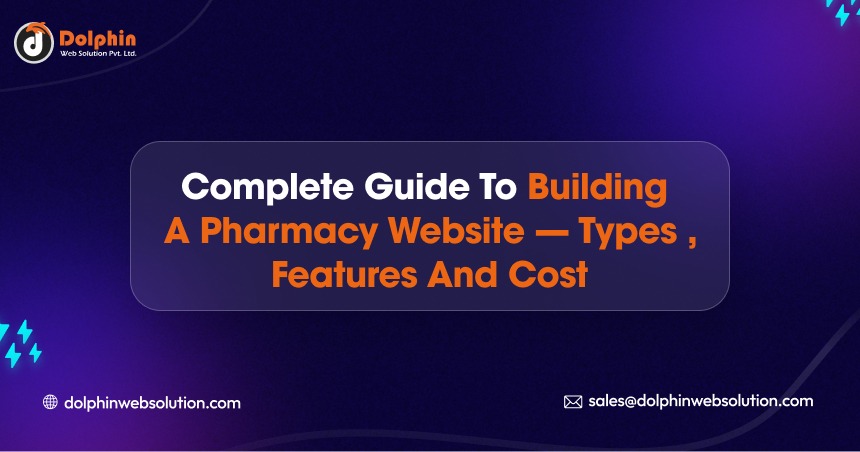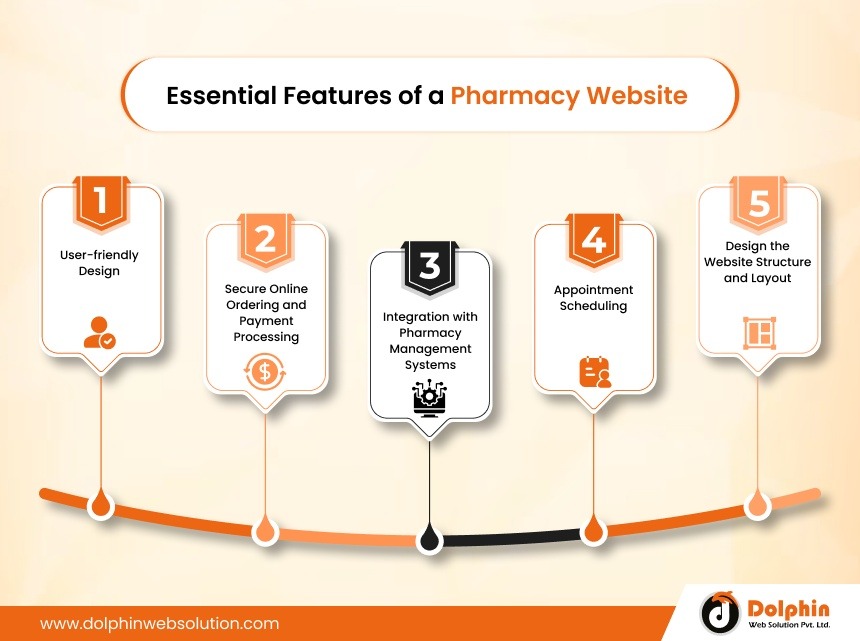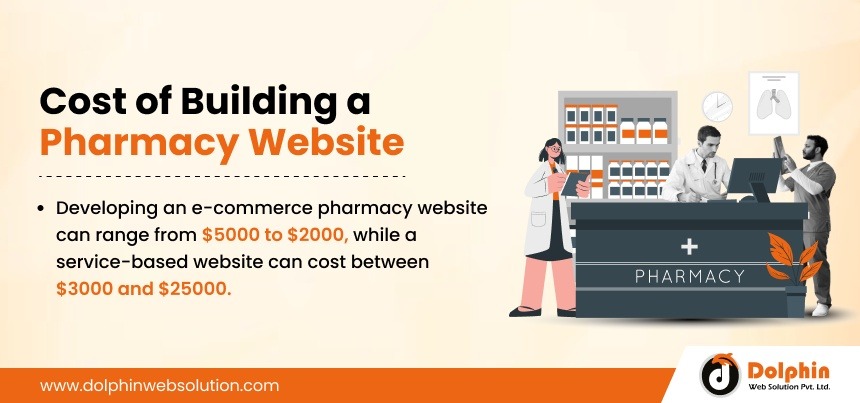Complete Guide to Building a Pharmacy Website : Types, Features, and Cost

Table of Contents
Summary :
The COVID-19 pandemic accelerated the development of pharmacy websites. These virtual platforms allow customers to browse, place orders, and receive healthcare items and pharmaceutical products online. Careful planning and execution are a must for building a pharmacy website. This ensures the pharmacy's and its customers' needs are met perfectly. Here's a step-by-step guide to help you create a successful pharmacy website.
Unlike traditional pharmacies, online pharmacies operate solely through digital platforms, eliminating the need for physical storefronts. Also, some online pharmacies may have a physical pharmacy, allowing you to place an order online and pick up your order from the physical store. The advantages of online pharmacies encompass various aspects, such as::
- Leveraging digital tools and technology, pharmacy websites provide pharmaceutical products at doorsteps while safeguarding sensitive data.
- Besides promoting improved medication adherence, online pharmacy shops offer convenient access to healthcare services and products.
- With a pharmacy website, healthcare companies can reach a broader customer base, which ensures potential market expansion.
- Online pharmacies are handy for individuals needing urgent medication, juggling busy schedules, or residing in various time zones. These digital platforms streamline operations by automating order processing, payment handling, and inventory control. By utilizing sophisticated inventory management systems, online pharmacies can monitor expiration dates, reduce wastage, and effectively monitor stock levels. This approach guarantees the consistent, continuous availability of crucial medications to customers.
- Also, digital pharmacies can leverage customer insights and data analytics to recommend personalized products, improving customer loyalty.
Understanding the Types of Pharmacy Websites
Before you start planning your pharmacy website, let us explore the different types of pharmacy websites that you can try out:
1. Informational Websites (Services Website)
Informational pharmacy websites are significant resources for consumers seeking reliable health information, medication guidance, and pharmacy services. They help users make informed decisions about their health and well-being. The chief components of such a website include health resources, drug information, wellness tips, health news and updates, pharmacy services, educational information for patients, online refills, interactive tools, contact information, FAQs, and so on.
2. E-commerce Websites
The demand for online pharmacies heightened during the COVID-19 pandemic, and people now find them more convenient than traditional stores. These pharmacies offer support to medical businesses. Through these sites, healthcare companies can assist their customers at a personal level and connect with them directly. Also, the products are delivered straight to the customer via the website, and customers can schedule appointments via phone calls or chats.
3. Hybrid websites
Hybrid pharmacy websites are comprehensive online platforms that combine informational content with e-commerce functionality. Such websites allow users to access authentic health information, pharmacy services, and products conveniently and securely. They support the pharmacy’s objective of promoting health and wellness while driving business growth. The principal features include Educational Content, Pharmacy Services, Drug Information, Online Ordering, Secure Payment Processing, Online Prescription Refills, Account Management, and Customer Support.
4. Patient Portal
Patient portal pharmacy websites offer patients secure access to their personal health information, medication records, and pharmacy services through a dedicated portal. The critical components of these websites include secure login, personal health records, medication management, communication with pharmacists, mobile accessibility, secure messaging and notification, privacy and security, appointment scheduling, and so on.
Essential Features of a Pharmacy Website
When creating a pharmacy website, it is vital to check that your website has all the essential features, such as:

1. User-friendly Design
The heart and soul of online shopping lies in a website’s interface – easy to use and intuitive, guiding customers through a seamless journey of exploration. The essentials lie in straightforward navigation menus, well-defined categories for healthcare offerings, and a visually captivating layout that captivates the eye. All these elements work hand in hand to guarantee every user a delightful adventure while browsing.
2. Secure Online Ordering and Payment Processing
A secure and robust online ordering is essential for facilitating convenient and safe transactions. Your pharmacy website should integrate industry-standard security measures like encryption and SSL certification to protect sensitive customer data during checkout.
3. Comprehensive Product Catalog
Maximize the assortment in your online pharmacy. Customers usually want to buy all the required healthcare products from one place. You need to have a comprehensive product catalogue that includes an extensive collection of healthcare products and services to retain a potential customer for your competitor.
Each healthcare product listing should have an availability status, detailed descriptions, pricing, and dosage information. It should also illustrate blocks with product analogs so customers can compare them on your website.
Also, include notifications about purchasing back-in-stock medicines, incompatible medicine, healthcare information, and other features to make your customers feel they are cared for.
4. Integration with Pharmacy Management Systems
Integrating a CRM system that can build a personal account for each customer can significantly impact the performance of your website. This will allow you to track user demand, regulate purchases, and make personalized offers to the client. For instance, you can remind your customers to shop for medicines they take regularly before running out.
This integration with pharmacy management systems allows seamless customer data, orders, and inventory synchronization between the backend pharmacy operations and the eCommerce platform. This integration minimizes errors, ensures enhanced order fulfilment, and streamlines business processes.
5. Appointment Scheduling
Implementing appointment scheduling functionality on a pharmacy website can enhance customer experience and streamline service delivery. If you offer healthcare services, ensure fast and easy appointment scheduling by phone calls or text messages. Prompt, responsive customer service will address customer inquiries, seamlessly schedule appointments, and resolve any issues, which helps build customer trust.
Building a Pharmacy Website: Step-by-Step Guide
Here are some of the essential steps that you should follow when building a pharmacy website:
1. Define Your Website Goals and Target Audience
Understand what you want to offer to your customers via your website: information on medications, online healthcare consultations, drug delivery, etc. Also, analyze what your target audience expects from your website if you want to tailor your pharmacy website to meet their specific needs and preferences. At the same time, if you’re going to enhance your user experience, drive engagement, and reach your business goals, then you need clarity about your objectives and the target audience.
2. Choose the Right Website Platform
When choosing a website platform for your pharmacy website, the chief considerations must include ease of use, scalability, customization options, integration capabilities, security features, and ongoing support and maintenance. The right platform should be selected based on your specific requirements and align with your goals and budget. Some notable choices of website platforms well-suited for building a pharmacy website include Magento, Shopify, WordPress, Squarespace, and Wix.
3. Design the Website Structure and Layout
As you begin designing your pharmacy website’s layout, opt for simplicity, clarity, and ease of navigation. The best option would be a clean, professional design with clear headings, intuitive menus, and prominent calls to action. This will be instrumental in guiding visitors to relevant sections of the website. The website should be mobile-responsive to offer a seamless browsing experience across devices. Reviewing and updating the website structure and layout should be scheduled regularly based on user feedback and evolving business requirements. The standard website structure must comprise the Homepage, About Us, Services, Products, Online Refills, Appointment Scheduling, Health Resources, and Contact Us pages.
4. Implement Essential Website Features
Your pharmacy website should have a responsive design that can adapt to different screen sizes. Also, integrate ease-of-access for people with disabilities to help them browse and purchase from your website. Other essential features to integrate:
- Filtering and Search options
- Shopping cart and safe checkout process
- Personalization and User Accounts
- Prescription verification
- Secured payment gateway
5. Test and Launch Website
There must be a step-by-step approach to ensure a smooth and successful launch of your pharmacy website and offer a valuable online platform to patients for accessing pharmacy services, information, and resources. The essential steps include functionality testing, reviewing the content, UX (User Experience) testing, performance testing, security testing, mobile responsiveness testing, accessibility testing, and browser compatibility testing. After the results of all these tests are positive, a final review should be done, and the authority’s approval should be obtained. Then, the website is ready for launch, and once it is launched, you can proceed with the promotion and marketing activities.
Cost of Building a Pharmacy Website

Developing an e-commerce pharmacy website can range from $5000 to $2000, while a service-based website can cost between $3000 and $25000. Prices for domain names typically range from $10 to $50 per year, depending on the domain registrar and the chosen domain extension. Hosting costs can range from $3 to $300+ per month, depending on the hosting provider and your hosting plan. The Development costs for simple pharmacy websites with primary features range from $500 to $5,000. In contrast, more complex sites with advanced e-commerce capabilities, integration with pharmacy management systems, and other custom features can cost $5,000 to $20,000 or more. Apart from this, there can be additional costs for getting eCommerce functionality, security, maintenance updates, and potential support costs.
Conclusion
Reliable developers should always be hired for Pharmacy website development services if you want the best results. Analyze your target audience and conduct market research before hiring website developers. Understand the industry-specific features that you need to integrate. Decide your goal and align your website features with it. The approach to building the pharmacy website will differ based on the other requirements, features, and the target audience it will reach. If you want to develop a pharmacy website, feel free to connect with Dolphin Web Solution.

